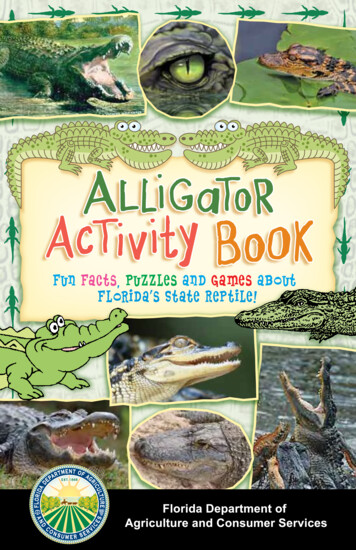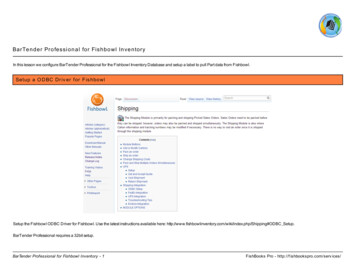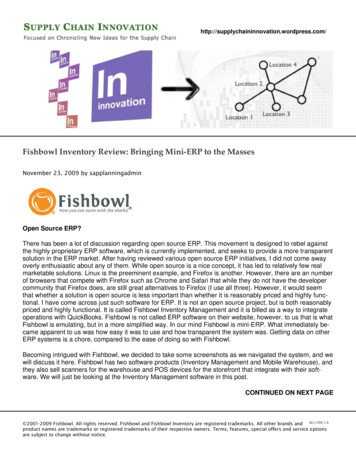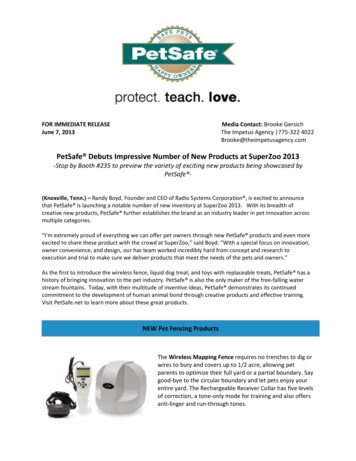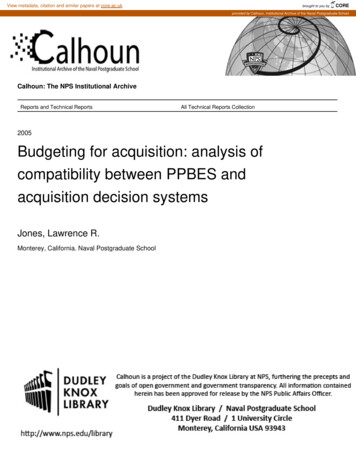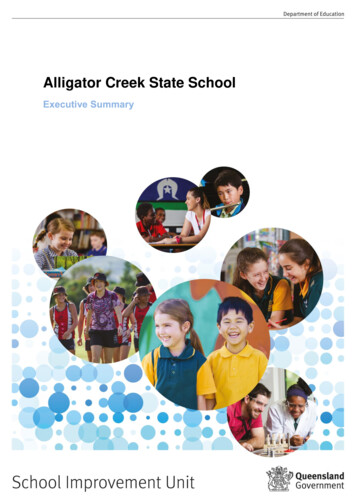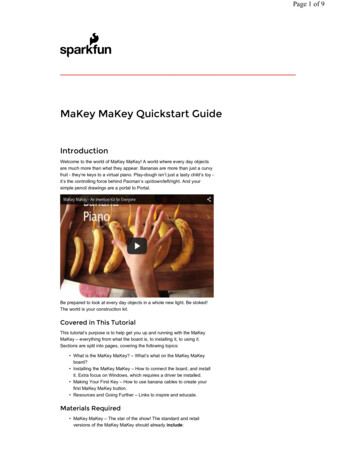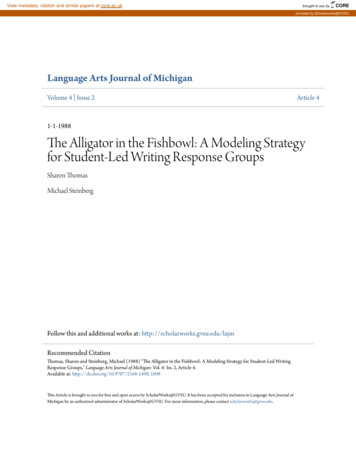
Transcription
View metadata, citation and similar papers at core.ac.ukbrought to you byCOREprovided by Scholarworks@GVSULanguage Arts Journal of MichiganVolume 4 Issue 2Article 41-1-1988The Alligator in the Fishbowl: A Modeling Strategyfor Student-Led Writing Response GroupsSharon ThomasMichael SteinbergFollow this and additional works at: http://scholarworks.gvsu.edu/lajmRecommended CitationThomas, Sharon and Steinberg, Michael (1988) "The Alligator in the Fishbowl: A Modeling Strategy for Student-Led WritingResponse Groups," Language Arts Journal of Michigan: Vol. 4: Iss. 2, Article 4.Available at: http://dx.doi.org/10.9707/2168-149X.1698This Article is brought to you for free and open access by ScholarWorks@GVSU. It has been accepted for inclusion in Language Arts Journal ofMichigan by an authorized administrator of ScholarWorks@GVSU. For more information, please contact scholarworks@gvsu.edu.
LANGUAGE ARTS JOURNAL OF MICHIGANTHE ALLIGATOR IN THE FISHBOWL:A MODELING STRATEGY FOR STUDENT-LEDWRITING RESPONSE GROUPSSharon Thomas and Michael SteinbergWe'd all like to teach in writing classrooms where students work coopera tively with each other and with us. But in experimenting with collaborativelearning techniques--spedfically, peer response groups--we've found thatmany students have difficulties adjusting to group work. A good number areunsure of their group roles; others are reluctant to make critical comments;some don't believe that they are even capable of giving useful advice.These problems arise out of a basic fear of taking risks. Having spentyears doing grammar workbook drills and exercises, and listening to lectureson writing, students have learned to be passive responders. For many, it's thepath of least resistance. Others tell of situations where they've departed from aparticular teacher's prescriptions and instead of being rewarded for taking theinitiative, they've found themselves punished or reprimanded. It's no wonderthen that they seem tentative and skeptical when we present them with a "new"group approach.But that doesn't mean that students aren't active, engaged learners. Awayfrom class they participate in all sorts of group activities: team sports, perfor 24
Volume 4, Number 2mances, clubs, and other extra-curricular activities. All of these depend oncollaboration, sharing, and risk-taking. As a way of encouraging students touse those abilities in the classroom, we've devised a modeling activity- "fishbowl" feedback--which introduces students to writing response groups.Our intent in using fishbowl demonstrations is three-fold: to give studentsan idea of the options and possibilities available to them during peer-groupactivities; to encourage them to participate in activities which will help oneanother grow; and to build a classroom community. Although we happen touse this activity in our freshman college composition classes, we are sure it canbe easily adapted to the high school and middle-school classroom community.One note before we explain the fishbowl: In discussing ways of giving andreceiving feedback, we distinguish between "response" and "editing.""Response" feedback is writer-based: it is expressive and informal and it di rects itself mainly at the writer's content. Generally it is most useful in the earlyor discovery stages of composing, when the writers are still exploring and ex perimenting. "Editing" feedback is reader-based and more formal. It directsitself to matters of structure and style. As such, it is most useful to writers in thelater stages of composing.Our first fishbowl of the term, therefore, is a "response" session. Forexample, when our students first listen to (or read through) a fellow writer'srough draft, we ask them not to critique it but simply describe and tell whatthey "hear" in the writer's draft. We begin this way because many studentstend to jump right into formal editing and critiquing. In the early stages ofwriting, student writers need to be encouraged to explore and to discover their25
LANGUAGE ARTS JOURNAL OF MICHIGANideas. So, when students respond informally to the content of a writer's roughdraft, it often helps the writer to discover or re-think the draft's meaning.As the students begin to shape their drafts for an audience, we do an other fishbowl demonstration on how to give and receive formal "editing"feedback. During this session, for example, students might discuss a draft'sstyle, voice, structure, focus, support, and so on. Then, as the piece comes toclosure, we ask students to carefully edit each other's final drafts for surfacecorrections.The fishbowl demonstration we'll describe below is an early term"response" session. The basic procedure goes like this:1. After they begin a piece of writing, students must bring their roughdrafts to class. The draft can be either a structured piece or a free flowing, still-Iooking-for-ideas draft. Our only request is that thepiece be at least two double-spaced pages.2. As a way of prompting them to think about possible questions to usewhen they're responding to each other's drafts, we ask the studentsto answer this question: "If you had access to the most wonderfuleditor in the world who would give you just exactly the help youneeded, but who wouldn't give you that help unless you asked theright questions, what would you ask?" As the students volunteerthese questions--questions like "Were my ideas clear?" "Was thereanything confusing?" "Where do I need more examples?" "Canyou follow what I'm saying?" "Is my point clear?" "How can I make26
Volume 4, Number 2my draft better?"-· we list them on the board under the labels,"Responding" and "Editing."3. Now we begin the "fishbow1." We ask for one volunteer to read hisor her draft aloud to a group of four or five other students. Thisgroup sits in the middle of the room (the fishbowl) and the rest ofthe class sits in a larger circle surrounding them.4. Before reading aloud, the writer chooses three or four questionsfrom the list on the board. For example, the writer might ask,"What can I do to make my point clearer?" or "Can you guys helpme get a better introduction?", and so on. The writer then readsthe draft aloud. Group members listen and jot down their re sponses. Knowing that inevitably those questions will lead to othersuggestions, initially we try to direct students to confine their writ ten responses to the three or four questions suggested by thewriter.5. Then an oral discussion of the paper begins, in which the group an·swers the writer's questions and makes suggestions for improve ment. If we feel the responders are being too critical or harsh, wesuggest that they talk first about the most successful parts of thedraft. In the best possible scenario, for example, the respondersmight suggest a more interesting introduction or some examplesor details that the writer needs to explain why he/she feels a spe cific way. As the group discusses the draft, writers can take notes orsimply listen in on the conversation. If writers feel that they are not27
LANGUAGE ARTS JOURNAL OF MICHIGANgetting useful feedback, they can join the conversation, ask moredirect questions, and/or offer additional information.6. Once the discussion ends, we ask the entire class--including thedemonstration group--to do a short written response which asksthem to consider things like whether the writer was specific enoughin asking for feedback, which of the group's comments seemedmost helpful, what problems they observed, what suggestions theywould make for improving the group, and so on.7. Finally, we call for a few volunteers to read their responses aloud. Asstudents offer comments, we record their suggestions on the board.By the end of the discussion, we've compiled a list of helpful guide lines for effective group work. We then type up and photocopy thislist and hand it out to the students for future reference.This is, of course, a best-case speculative scenario; but regardless of howthe first fishbowl session goes, we've found it to be a good ice-breaker.In the past, we've used the activity at the beginning of the term, solely as aprelude to the first peer responding and editing sessions. But, because of itssuccess, we've recently begun doing additional fishbowl sessions as refreshersand follow-ups.A description of one of these "fishbowl" sessions might be useful atthis point, so we'd like to describe an actual early-term session that occurredrecently in one of our classes. In this particular class--a freshman camp sec tion--the students had already generated a list of questions and formed the28
Volume 4, Number 2"fishbowl." They had agreed on a procedure: after the writer had read his orher piece and asked some questions, the group would discuss these questionswhile the writer listened in and took notes.Mark, a big, gregarious football player, volunteered to read his draft. Thepaper, a kind of free associative personal essay, was written in response to an"interest inventory" of topics that the students had made up themselves. Markchose to write the story of how he once got caught by his parents when hesneaked horne from college one weekend to visit his girlfriend.After Mark read aloud, it was apparent to us that the story's strong suit wasits appeal to its audience--fellow college students. Because this was an earlydraft, it had some problems typical of most rough drafts, discovery writing:Mark had left out some major events which were important to the story and hehad included some irrelevant information, usually in the form of dialogue.He'd also neglected important transitions and time markers.Predictably, the student responders were shy about taking the initiative.Some hadn't even bothered to take any notes. To get things started, Markasked the group if they could follow his paper. If not, he inquired, what couldhe do to make it clearer? After a longish, uncomfortable silence, Karen, atalkative, friendly girl, began the responses. She made several general com ments about how good Mark's paper was and how much she enjoyed hearingthe story about his girlfriend. Then abruptly she stopped.After a few moments of more uneasy silence, she began again. This timeshe asked, "Why didn't you want your parents to know that you were corninghorne to visit your girlfriend? How did they find out you were there?" Mark29
LANGUAGE ARTS JOURNAL OF MICHIGANstarted to respond, but another member of the group pointed out that he wassupposed to listen, take notes, and respond later.Laura, a qUiet, serious girl, volunteered next. She, too, said that she likedthe paper; but she wanted to know why Mark had called his brother-in-lawwhen his car broke down. She also wanted to know how Mark got back toschooL Then Jim, a smallish, shy boy, chimed in. He wanted to know why Markhad included all that conversation with his roommate--something about a testcoming up. What did the test have to do with going to see his girlfriend?Then everyone began talking at once and, in about five minutes, theycame to the following conclusions: Mark had a good story that they were all in terested in hearing more about. But they agreed that he had left out some im portant events that were necessary to the story; he had included someinformation that didn't seem to go anywhere; and his chronology was confus ing.Even with the tentative start, after about ten minutes, these students hadcome to the same conclusions about Mark's paper that most teachers wouldhave. So far, so good.Then it was Mark's turn to respond. His parents didn't dislike his girl friend, he said; they just wanted him to concentrate on his schoolwork so thathe wouldn't lose his football scholarship. He had been so easily discovered be cause his girlfriend lived only four houses from his parents. And then came themost important revelation: Mark's sister had seen him and his girlfriend at alocal shopping center where they had gone to buy Mark a baby alligator. Fi nally, Mark told the group that his brother-in-law drove him back to school be 30
Volume 4, Number 2cause his car had a heater. "I had to keep the alligator warm, didn't I?" Marksaid.As soon as Mark mentioned the alligator, the atmosphere in the class room changed. Several students sitting in the outer circle tried to make sug gestions all at once.We noted their interest and instead of confining thedemonstration to the inner circle, we decided that this was a good time to openthings up. So we let those in the outer circle join in. "You need to tell moreabout the alligator. It was the alligator that made you get caught. Why did youbuy the alligator in the first place? Why not put something about the alligatorin your title?" Now, Mark began to ask his own questions and take notes onwhat was being said. What should he cut? What should he condense? Howcould he work the story about the alligator into his paper? And so it went forthe rest of the session.This scenario demonstrates what can happen when students have the op portunity to work collaboratively. Not knowing what was expected of them andnot having much experience at this sort of thing, the group started slowly, ten tatively. Several times, group members kept looking back at the teacher inhopes that she would relieve them of their responsibility. But, eventually, thesedisparate, confused students evolved into a group of active, even lively, listen ers and responders. Instead of simply correcting Mark's draft, they helpedhim re-think it. More importantly, they helped Mark discover the key to hispaper: the alligator.After the fishbowl was over, we asked all the students--Mark included-- todo a short freewrite on their responses to what worked and what didn't. In theirfreewrites, the students were able to pOint out glitches and successes as well as31
LANGUAGE ARTS JOURNAL OF MICHIGANmake suggestions (which we recorded on the board) for improving future re sponse groups.Not all fishbowl demonstrations turn out to be as lively and helpful as thisone did. Even so, having students model this process almost always helpsthem to feel freer to respond and to collaborate with one another. Marks' peergroup is also evidence that students in the fishbowl learn some specific,practical things about writing, responding, and editing. For example:--Students become more aware of their audience. After a fewcompliments and some general questions, Mark's groupgot down to business. By the time the students were fin ished asking their questions and giving their responses,Mark had a very clear picture of his audience and heknew the kinds of information they needed before they'dunderstand his story.--Students learn to take risks with their wriHng. Mark did. Hevolunteered to read his paper aloud and found the expe rience worthwhile. In his final draft, the alligator figuredas a major character in the narrative.--Students learn to work collaboratively. After wasting sometime and not getting to the point, Mark's group discoverednew possibilities in his paper as they discussed it with oneanother.--Students become more aware of the importance of revision.By the time the session was over, Mark knew what he hadto do next. And he was already beginning to revise his pa per.--Students learn to focus and develop their ideas.Markfound his focus: the alligator.--Students learn to identify major (and minor) writing prob lems. Mark's paper still had several major and minorproblems, but he discovered he could address these inlater drafts. As a result of this first session, Mark was able32
Volume 4, Number 2to work on the problems that needed attention at thispoint in the process.In general, the experience of constructively responding to and critiquingeach other's writing boosts students' confidence, makes them more aware ofthe value of feedback, and encourages them to apply more care and scrutinyto their own writing. In addition, each fishbowl experience builds for the nextone: The students in Mark's demonstration group were only novice respon ders, but because they had the opportunity to work together, they discoveredsome of the problems inherent in group work as well as how to share in thebuilding of a supportive classroom community.Though certainly not a cure-all for the problems created by collaborativelearning, beginning with a few fishbowl demonstrations gives students andteachers an idea of what's possible: given time, guidance, and the opportunityto work with one another in a non-punitive environment, most students canbecome effective responders and critics.Having worked with fishbowl demonstrations for some time, we've alsolearned the value of patience and restraint. Before students can develop theconfidence and skill which make response groups work, they need time to ex plore and to build up some trust among themselves and between themselvesand their teachers. Moreover, students do not always know what we meanwhen we ask them to participate in their own learning. Getting involved in thefishbowl encourages them to use some of the resources they already possess,and it rewards them for applying those resources to classroom learning. Fi nally, the fishbowl demonstration lets students know that learning how to cri 33
LANGUAGE ARTS JOURNAL OF MICHIGANtique each other's writing is at least as valuable, if not more so, as teacher input,We've found that often they not only find the problems in each other's writingthat we would find, but they discover many inventive solutions that we'd neverthink of.In closing, we'd like to suggest that teachers and curriculum coordina tors consider using more collaborative thinking strategies like this one at allgrade levels, K-college. For although our fishbowl demonstration was originallydesigned to help students compose an expressive piece of writing, the activity(and others like it) can be useful in guiding students as they write argument,exposition, and analysis--in the other diSciplines as well as in our Englishclasses. In asking students to work with each other and monitor their owncomposing processes, we are encouraging them to speculate, to inquire, to re flect, to formulate questions, and to critique their own and others' writing. Inother words, we're indirectly urging them to write and think more critically.To that end, we've recently begun experimenting with using the fishbowlas a way not only of modelling writing strategies, but also of demonstrating avariety of techniques which connect thinking and writing with literature andother content-area reading, In the final analYSiS, the fishbowl is a strategywhich gives students the chance to become more aware, active, and engagedlearners. Such activities are worth whatever risks we, as teachers, are willing totake.34
Volume 4, Number 2Sharon Thomas teaches in the Department of American Thoughtand Language at Michigan State University.Currently, she is doingresearch and designing a variety of reading/writing strategies aimedat freshman, developmental-level students.Michael Steinberg also teaches in the American Thought andLanguage Department at MSU.He is co-coordinator of the TraversBay Summer Workshops and he does in-service consulting for severalschools in Michigan.35
the first fishbowl session goes, we've found it to . be . a good ice-breaker. In the past, we've used the activity at the beginning of the term, solely as a prelude to the first peer responding and editing sessions. But, because of its success, we've recently begun doing additional fishbowl sessions as refreshers and follow-ups.
